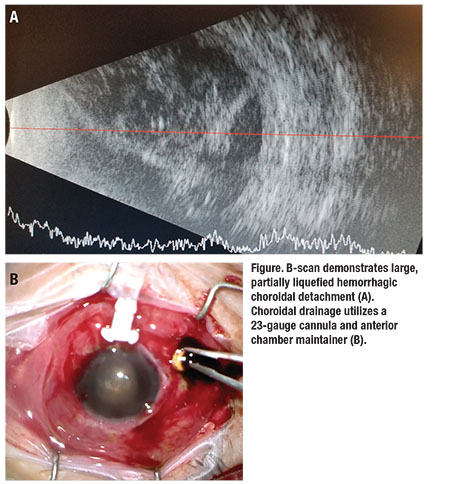Timing and Planning
Delaying surgery up to two weeks can allow liquefaction of a clot to improve surgical clearance. With “kissing” choroidals or uncontrolled intraocular pressure, one may wish to intervene sooner. Preoperative B-scan ultrasonography may help identify liquefaction and localize the largest choroidals as optimal quadrants for drainage (Figure A).
Anterior Chamber Infusion
Successful drainage requires IOP control. The view posteriorly is often compromised, and an anterior chamber maintainer, or a vitrectomy cannula attached to an infusion line as an elegant and readily available alternative, should be placed to avoid misplacement of the posterior trocar, which can pierce the retina or infuse into the choroidal space. Deepening a shallow anterior chamber with viscoelastic is helpful to facilitate safe anterior chamber insertion. Transient IOP elevation (for example, to 60 mmHg) facilitates drainage of hemorrhage.
Scleral Cut-Down Vs. Trocar Insertion
The video demonstrates how surgeons can employ various techniques to facilitate drainage. Scleral cut- down involves a targeted conjunctival peritomy to expose bare sclera over the previously identified
 |
When the suprachoroidal space is accessed, a gush of dark red liquefied heme will typically appear. Detachment of the choroid protects against full-thickness penetration into the vitreous cavity. Consider inserting a cyclodialysis spatula into the suprachoroidal space to keep the cut-down open for egress of the hemorrhage and to clear clots that obstruct flow. Focal pressure applied to the anterior lip of the wound and/or ocular massage can help maximize drainage.
As an alternative to a cut-down, one can insert a 23- or 25-gauge cannula. An angled-20° approach has been found beneficial to position in the suprachoroidal space.1 If using a valved cannula, cut the valve off with the vitrector or use forceps to maintain patency.
Avoid Vitrectomy If Possible, Remember Goals of Surgery
The goals of hemorrhagic choroidal drainage are to eliminate appositional or large, nonappositional choroidals, normalize IOP and eliminate posterior pressure on the lens-iris diaphragm. This can be obtained without complete choroidal drainage. Unless the pathology requires, avoid a concurrent vitrectomy. If a vitrectomy is performed, perfluorocarbon liquid may help displace remaining hemorrhage anteriorly.2
Other refinements to these techniques have been developed to manage this often complex scenario. As always, multiple approaches in your armamentarium increase your likelihood of success. RS
Dr. Hahn is an associate at New Jersey Retina in Teaneck. Dr. Cohen is a second-year vitreoretinal surgery fellow at Ophthalmic Consultants of Boston and Tufts Medical Center in Boston. Dr. Shah is co-director of the vitreoretinal fellowship program at Ophthalmic Consultants of Boston and Tufts Medical Center, and a vitreoretinal specialist at Ophthalmic Consultants of Boston.
REFERENCES
1. Rezende FA, Kickinger MC, Li G, et al. Transconjunctival drainage of serous and hemorrhagic choroidal detachment. Retina. 2012;32:242-249.
2. Desai UR, Peyman GA, Chen CJ, et al. Use of perfluoroperhydrophenanthrene in the management of suprachoroidal hemorrhages. Ophthalmology. 1992;99:1542-1547.




